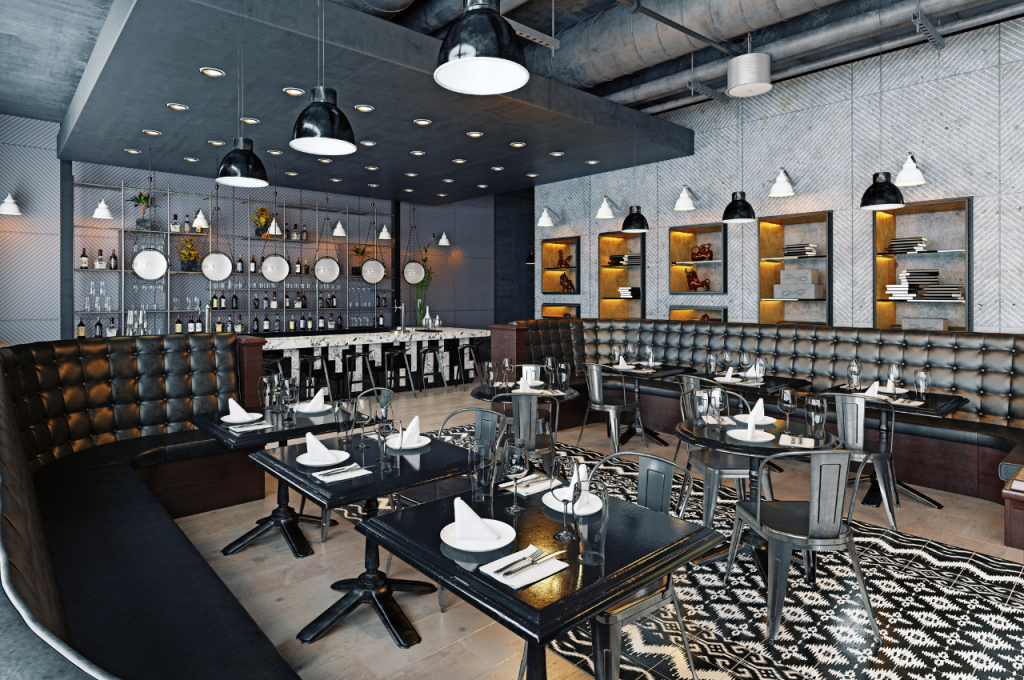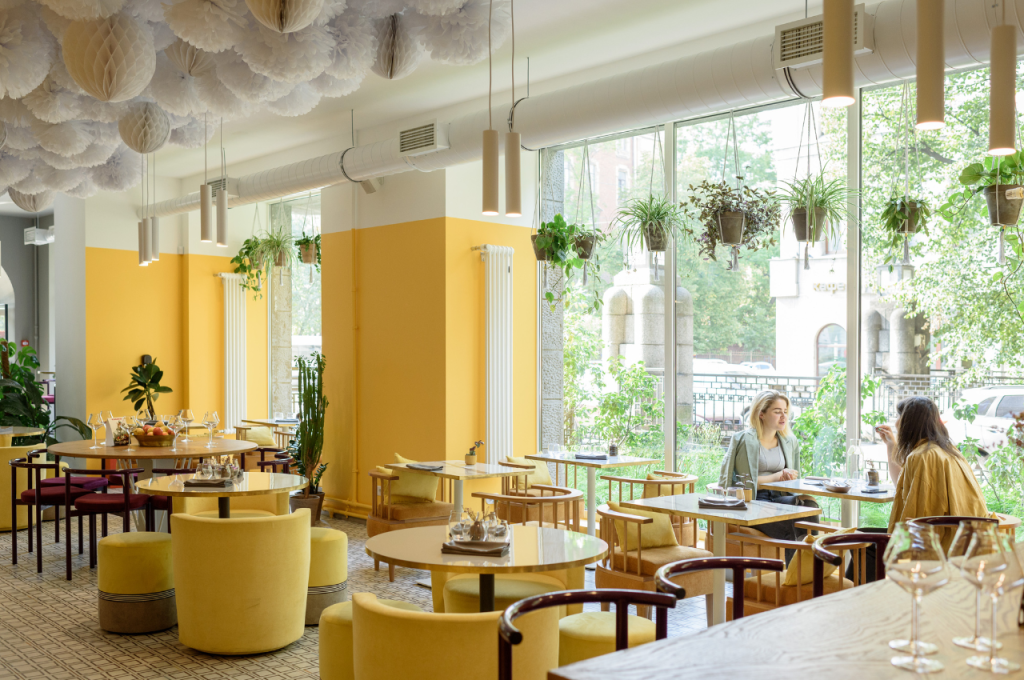Restaurant interior design is crucial for creating a welcoming and appealing atmosphere. It significantly impacts the overall dining experience and influences customer satisfaction and retention.
A well-designed restaurant interior should reflect the brand’s identity, create a comfortable and functional space, and enhance the overall dining ambiance. This includes a careful selection of materials, color schemes, lighting, seating arrangement, and decor elements. An effective interior design plan considers the target audience, menu, and service style to ensure a cohesive and harmonious dining environment.
By focusing on aesthetics, functionality, and brand representation, restaurant owners can elevate the overall dining experience and distinguish their establishments in a competitive market.
Importance of Restaurant Interior Design
Restaurant interior design goes beyond aesthetics, it’s about creating an immersive environment that enhances the dining experience and leaves a lasting impression on customers. From the layout and decor to the lighting and ambiance, every aspect of restaurant design plays a crucial role in shaping the overall atmosphere and influencing customer perceptions.

Enhancing Customer Experience
A well-thought-out restaurant interior design can significantly enhance the overall customer experience. From the layout of the dining area to the choice of furniture and lighting, every element plays a crucial role in shaping the way patrons perceive the establishment. By creating a cozy and inviting atmosphere, restaurants can promote customer satisfaction and loyalty.
Reflecting Brand Identity
The interior design of a restaurant serves as a visual representation of the brand’s identity. Whether it’s a modern, minimalist vibe or a rustic, vintage ambiance, the decor and furnishings should perfectly align with the restaurant’s unique identity and theme. This visual cohesion strengthens brand recognition and creates a memorable impression on customers.
Factors to Consider Before Designing
Before designing a restaurant’s interior, several crucial factors need to be considered to ensure that it effectively caters to the needs of both the business and its customers. By understanding the target audience and demographics, as well as optimizing space utilization, a restaurant’s interior can create a welcoming, functional, and aesthetically pleasing environment.
Target Audience and Demographics
Understanding the target audience and demographics is vital when designing a restaurant’s interior. Factors such as age, income level, and cultural background play a significant role in determining the ambiance, seating arrangements, and overall interior design. For example, a restaurant targeting a younger demographic may opt for modern and trendy decor, while a family-oriented establishment may prioritize spacious seating and a warm, inviting atmosphere.
Space Utilization
Efficient utilization of space is essential in restaurant interior design. Factors such as the layout of the kitchen, seating capacity, and flow of foot traffic all contribute to the overall dining experience. By strategically positioning seating areas, creating designated waiting spaces, and optimizing the placement of service areas, a restaurant can enhance both functionality and customer satisfaction. Additionally, incorporating flexible design elements that allow for various seating configurations can accommodate different group sizes and dining preferences.
Design Elements to Elevate Ambiance
Elevating the ambiance of a restaurant involves careful consideration of various design elements. Two key factors that significantly impact the overall atmosphere are:
Color Scheme
The color scheme plays a crucial role in setting the tone and mood of the restaurant.
- Warm tones like red and orange can create a cozy and intimate feel.
- Cool tones such as blue and green promote a more relaxed and calming atmosphere.
- Neutral colors like beige and grey offer a timeless and sophisticated look.
Lighting
Proper lighting can enhance the dining experience and accentuate the design elements of the space.
- Dimmer lights can create a romantic ambiance for evening dining.
- Natural light from large windows can make the space feel open and airy.
- Statement light fixtures can serve as focal points and add a touch of elegance.
Aside from color scheme and lighting, another vital aspect is the choice of.
Incorporating Unique Features
This restaurant’s interior design incorporates unique features to create an unforgettable dining experience. With attention to detail, the space blends modern elements with rustic charm, resulting in a one-of-a-kind ambiance that guests won’t find elsewhere.
Artwork and Decorative Pieces
The artwork and decorative pieces in a restaurant can make a world of difference in creating a unique and memorable dining experience. Instead of relying on generic posters or paintings, consider investing in custom pieces that reflect the overall theme and ambiance of your restaurant.
One option is to commission a local artist to create original artwork specifically for your establishment. This not only adds a personalized touch but also supports the local community. Bold and vibrant paintings can serve as focal points, while smaller decorative pieces like sculptures or ceramics can add interest to empty spaces.
To encourage conversation and engagement among customers, you might also consider incorporating interactive art installations. These can range from interactive digital screens showcasing local artists’ work to three-dimensional installations that invite guests to become part of the artwork itself.
Greenery and Natural Elements
Bringing nature indoors is another fantastic way to incorporate unique features into your restaurant’s interior design. Plants and greenery not only add aesthetic appeal but also provide numerous benefits to the overall ambiance and well-being of guests.
Consider creating a living wall or installing vertical gardens, where plants can flourish and create a striking visual display. Alternatively, strategically placing potted plants and hanging foliage throughout the restaurant can enliven the space and give it an inviting, organic feel.
In addition to traditional plants, you may also want to incorporate other natural elements such as water features or natural wood finishes. A small indoor fountain can create a serene and calming ambiance, while wood accents can add warmth and a rustic touch.
Technology Integration for Modern Appeal
With the integration of modern technology, restaurant interior design has taken on a new appeal. Technology advancements have allowed for the seamless integration of digital menus, interactive ordering systems, and atmospheric lighting, creating a unique and captivating dining experience.

In the fast-paced world of restaurant design, leveraging technology is crucial to create a modern and appealing atmosphere. From interactive menu screens to smart lighting systems, technology integration enhances the overall dining experience for customers. Let’s explore how these advancements contribute to outstanding restaurant interior design.
Interactive Menu Screens
Interactive menu screens revolutionize the way customers engage with a restaurant’s offerings. By replacing traditional printed menus, these digital displays provide a dynamic and engaging interface that allows guests to browse through a wide range of options. With the touch of a button, menu screens can display enticing food images, provide detailed descriptions, and even suggest popular combinations or special offers. Not only do interactive menu screens enhance the visual appeal of a restaurant, but they also streamline the ordering process. Customers can easily browse the menu, customize their orders, and even make payments directly on the screen. This eliminates potential communication errors, reduces wait times, and enhances overall customer satisfaction.
Smart Lighting Systems
Smart lighting systems play a significant role in creating the perfect ambiance for a restaurant. They offer the flexibility to adjust the lighting levels and colors, enabling establishments to set the mood according to the time of day or the desired atmosphere. The ability to dim or brighten lights can create an intimate and cozy setting for a romantic dinner or a vibrant and energetic environment for a lively gathering. Furthermore, smart lighting systems can be programmed to change throughout the day, mimicking the natural transition of sunlight. This promotes a pleasant dining experience that aligns with the body’s circadian rhythm, enhancing comfort and overall well-being. With the integration of automated lighting controls, restaurants can also save energy by ensuring lights are only on when needed, reducing their environmental impact.
Budget-friendly Design Tips
Uncover ingenious strategies to revamp your restaurant’s interior without breaking the bank, courtesy of these cost-effective design insights.
Repurposing Existing Elements
Look for innovative ways to repurpose existing furniture and decor items.
- Repaint old chairs and tables for a fresh look.
- Convert unused wood pallets into rustic wall decor.
- Repurpose mason jars as unique light fixtures.
Diy Decor Projects
Engage in do-it-yourself projects to add a personal touch to your restaurant’s design.
- Create custom artwork using inexpensive materials.
- Design your table centerpieces using affordable items.
- Spruce up plain walls with handmade tapestries or murals.
Case Studies in Successful Design Implementation
When it comes to restaurant interior design, successful implementation is key to creating a memorable dining experience. Let’s explore some case studies that showcase how renowned restaurants and local eateries have transformed their spaces through strategic design choices.
Renowned Restaurant’s Makeovers
Renowned restaurants’ impeccable interior design makeovers play a pivotal role in attracting and retaining patrons.
Local Eaterie’s Success Stories
Local eateries’ innovative design implementations demonstrate how creativity and functionality intertwine to elevate the dining environment.
Consulting Experts for Design Optimization
When it comes to restaurant interior design, consulting experts for design optimization is crucial. It’s a strategic approach that ensures the interior space is not only visually appealing but also functional and inviting for customers. Restaurant owners and managers can greatly benefit from collaborating with design professionals who have the expertise to enhance the dining experience through creative and practical interior design solutions.
Benefits of Hiring Professional Designers
- Access to specialized knowledge and expertise
- Efficient utilization of space and resources
- Customized designs tailored to the brand’s identity
- Enhanced customer experience and satisfaction
- Integration of industry trends and innovative concepts
- Professional project management and execution
Collaborating with Decor Specialists
Collaborating with decor specialists allows for seamless integration of the overall design concept with specific decorative elements. It brings meticulous attention to detail, ensuring that every aspect of the interior, from furniture and lighting to color schemes and accessories, contributes to the ambiance and style of the restaurant. By leveraging the expertise of decor specialists, restaurant owners can achieve a cohesive and visually stunning interior that reflects the brand’s personality and resonates with the target audience.

Conclusion
Incorporating thoughtful design elements can elevate the dining experience. From lighting to seating, every detail matters. A well-designed restaurant interior can leave a lasting impression on customers. Remember, the ambiance plays a crucial role in creating a welcoming and memorable atmosphere for guests.
Make your restaurant interior a true reflection of your brand.

